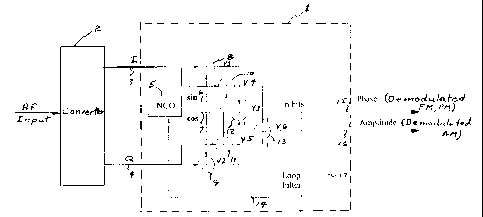Some of the information on this Web page has been provided by external sources. The Government of Canada is not responsible for the accuracy, reliability or currency of the information supplied by external sources. Users wishing to rely upon this information should consult directly with the source of the information. Content provided by external sources is not subject to official languages, privacy and accessibility requirements.
Any discrepancies in the text and image of the Claims and Abstract are due to differing posting times. Text of the Claims and Abstract are posted:
| (12) Patent: | (11) CA 2284948 |
|---|---|
| (54) English Title: | COMPLEX PHASE-LOCKED LOOP DEMODULATOR FOR LOW-IF AND ZERO-IF RADIO RECEIVERS |
| (54) French Title: | DEMODULATEUR A BOUCLE A VERROUILLAGE DE PHASE COMPLEXE POUR RECEPTEURS RADIO A FI BASSE OU NULLE |
| Status: | Expired and beyond the Period of Reversal |
| (51) International Patent Classification (IPC): |
|
|---|---|
| (72) Inventors : |
|
| (73) Owners : |
|
| (71) Applicants : |
|
| (74) Agent: | GOWLING WLG (CANADA) LLP |
| (74) Associate agent: | |
| (45) Issued: | 2003-12-09 |
| (22) Filed Date: | 1999-10-04 |
| (41) Open to Public Inspection: | 2001-04-04 |
| Examination requested: | 1999-11-12 |
| Availability of licence: | N/A |
| Dedicated to the Public: | N/A |
| (25) Language of filing: | English |
| Patent Cooperation Treaty (PCT): | No |
|---|
| (30) Application Priority Data: | None |
|---|
A digital demodulator which coherently demodulates a low-IF or zero-IF complex
signal using a complex-valued phase-locked loop (CPPL). The CPPL includes a
numerical controlled oscillator, four multipliers and two combiners to provide
independent phase/frequency and amplitude outputs. The CPLL exhibits in first
order
PLL dynamics without a loop filter in the feedback loop to the NCO. However a
filter
with one or more poles may be included in the feedback circuit to exhibit 2 nd
or higher
order PLL dynamics. The CPLL allows coherent demodulation of extremely low FM
modulation indexes whereby the incoming frequency drift may be larger than the
frequency deviation. It can also be used to coherently demodulate signals
which have
combined amplitude and phase characteristics.
Note: Claims are shown in the official language in which they were submitted.
Note: Descriptions are shown in the official language in which they were submitted.

2024-08-01:As part of the Next Generation Patents (NGP) transition, the Canadian Patents Database (CPD) now contains a more detailed Event History, which replicates the Event Log of our new back-office solution.
Please note that "Inactive:" events refers to events no longer in use in our new back-office solution.
For a clearer understanding of the status of the application/patent presented on this page, the site Disclaimer , as well as the definitions for Patent , Event History , Maintenance Fee and Payment History should be consulted.
| Description | Date |
|---|---|
| Inactive: IPC removed | 2014-10-02 |
| Time Limit for Reversal Expired | 2008-10-06 |
| Letter Sent | 2007-10-04 |
| Inactive: IPC from MCD | 2006-03-12 |
| Inactive: IPC from MCD | 2006-03-12 |
| Grant by Issuance | 2003-12-09 |
| Inactive: Cover page published | 2003-12-08 |
| Letter Sent | 2003-08-08 |
| Letter Sent | 2003-08-08 |
| Letter Sent | 2003-08-08 |
| Inactive: Correspondence - Transfer | 2003-06-30 |
| Pre-grant | 2003-06-30 |
| Inactive: Final fee received | 2003-06-30 |
| Notice of Allowance is Issued | 2002-12-31 |
| Notice of Allowance is Issued | 2002-12-31 |
| Letter Sent | 2002-12-31 |
| Inactive: Office letter | 2002-12-18 |
| Inactive: Approved for allowance (AFA) | 2002-11-25 |
| Application Published (Open to Public Inspection) | 2001-04-04 |
| Inactive: Cover page published | 2001-04-03 |
| Letter Sent | 2000-06-28 |
| Inactive: Multiple transfers | 2000-05-23 |
| Letter Sent | 1999-11-30 |
| Inactive: First IPC assigned | 1999-11-19 |
| All Requirements for Examination Determined Compliant | 1999-11-12 |
| Request for Examination Requirements Determined Compliant | 1999-11-12 |
| Request for Examination Received | 1999-11-12 |
| Letter Sent | 1999-10-28 |
| Inactive: Filing certificate - No RFE (English) | 1999-10-28 |
| Filing Requirements Determined Compliant | 1999-10-28 |
| Application Received - Regular National | 1999-10-26 |
There is no abandonment history.
The last payment was received on 2003-09-23
Note : If the full payment has not been received on or before the date indicated, a further fee may be required which may be one of the following
Please refer to the CIPO Patent Fees web page to see all current fee amounts.
| Fee Type | Anniversary Year | Due Date | Paid Date |
|---|---|---|---|
| Application fee - standard | 1999-10-04 | ||
| Registration of a document | 1999-10-04 | ||
| Request for examination - standard | 1999-11-12 | ||
| Registration of a document | 2000-05-23 | ||
| MF (application, 2nd anniv.) - standard | 02 | 2001-10-04 | 2001-09-20 |
| MF (application, 3rd anniv.) - standard | 03 | 2002-10-04 | 2002-09-26 |
| Registration of a document | 2002-11-06 | ||
| Final fee - standard | 2003-06-30 | ||
| MF (application, 4th anniv.) - standard | 04 | 2003-10-06 | 2003-09-23 |
| MF (patent, 5th anniv.) - standard | 2004-10-04 | 2004-09-21 | |
| MF (patent, 6th anniv.) - standard | 2005-10-04 | 2005-09-21 | |
| MF (patent, 7th anniv.) - standard | 2006-10-04 | 2006-09-18 |
Note: Records showing the ownership history in alphabetical order.
| Current Owners on Record |
|---|
| SKYWORKS SOLUTIONS, INC. |
| Past Owners on Record |
|---|
| NEIL BIRKETT |
| NORM FILIOL |
| THOMAS RILEY |